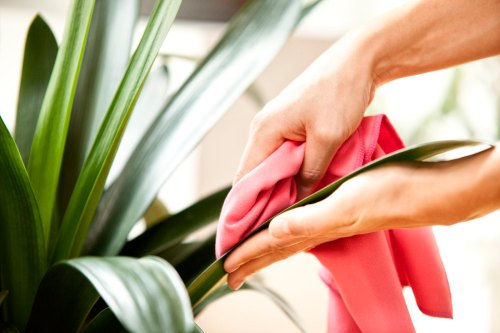Our editors independently select these products. Making a purchase through our links may earn Well+Good a commission
How to properly remove dust from your home—because we’re definitely all making the same mistake
Turns out, there's a wrong way to remove dust, and using a traditional duster or a cotton cloth is your first mistake. Here's how to remove dust.

Every time I dust around the house, I wonder if I’m actually removing dust or just swirling it into the air. I get my answer when I wake up the next day feeling like there’s a family of dust bunnies living in my throat. Turns out, there’s a wrong way to remove dust, and using a traditional duster or a cotton cloth is your first mistake.
“Taking a feather duster and running around with that all over your house you’re just flinging dust in the air,” says Marilee Nelson, co-founder of Branch Basics. “Cleaning with typical rags or dusters actually just spreads dust. If you get a wet cotton cloth and you think you’re gonna dust, you’re actually just spreading it around, and when you finish you look and you see this line of dust.”
This may not seem like a big deal, but dust is more than little annoying fluffs. “Every surface area, especially porous ones, generates dust,” says Nelson. And all the not-so-great things in the air like to cling to dust.
“Depending on your home, dust can have biological contaminants like bacteria, viruses, mold, and mildew. If you’ve got pets, animal dander, cat saliva, and dust mites. Also cockroach [parts and secretions], and pollen,” says Nelson. Dust also carries SVOCs, or semivolatile organic compounds, that are emitted from materials and products like plasticizers from plastic products and flame retardants from upholstered furniture. “Unlike VOCs, that you can smell and that warn you of their presence, SVOCs are called stealth chemicals. They are odorless, ride on dust, and are insidious underminers of our health.”
Dust is definitely not something you want to play with—here’s how to properly remove it.
How to remove dust the right way
To actually remove dust, you’ll want to start with microfiber cloths.
“A really good microfiber cloth is one of the best cleaning tools money can buy,” says Nelson. “It’s reusable, inexpensive, it grabs, dust, dirt, it does an amazing job of just holding on to those particles, and you can use it dry or damp.” Nelson recommends the Perfect Clean All-Purpose Wipers ($11) and Swiffer Sweeper Unscented Dry Cloths ($5).
If you like to use a damp cloth, Nelson you can spray it with a bit of your favorite all-purpose cleaner, like the Branch Basics All-Purpose Cleaner ($5). Angela Bell, a grove guide at Grove Collaborative says to use an oil-based wood cleaner when dusting wooden surfaces. “It will not only wipe away dust but, leave wood looking polished and refreshed,” she says.
Georgia Dixon, a grove guide at Grove Collaborative, says vacuuming dust helps keep excess dust from spewing in the air. “I actually use my vacuum on dusty surfaces before cleaning the floor. For example, I use it on the chair rail in the bedrooms and bathroom before I do any dusting, that way there is less dust building up on the cleaning cloth,” she says. “I use the upholstery brush attachment head to avoid scratching hard surfaces like the wall or trim.”
Remembering all the icky stuff that clings to dust, Bell says you may want more than just your dusting tools when cleaning a super dusty area.
“If you are tackling a neglected area like a basement or attic, or if you have moved into a new space with old dust, it might be worth purchasing a mask to prevent lung or sinus irritation and wearing cleaning gloves,” says Bell. “If you feel like your space is especially prone to dust, look into an air purifier as an option. The filtration system traps in dust and can be extremely useful for those with allergies or sensitive systems.”
Areas to dust regularly
Ceiling fans, air vents, and vent fans are all areas you’ll want to dust regularly. “Air vents push warm or cool air into your home and tend to stir up general dust in the area and can push it towards the walls, window sills, and ceiling,” says Bell. “Vent fans, like the ones in your bathroom, are pulling moist air out of the space. You’ll notice that dust and hair will start to build up on the vent itself.” Nelson adds that radiators are also dust collectors. “The heat coming off of it generates air movement, and that means it’s throwing off the dust,” says Nelson.
Dixon says to make sure you’re also regularly giving shelves a good dusting. “It may be tempting to just do a quick once-over when it comes to book or record shelves, but tackling these areas regularly can help prevent dust elsewhere,” she says. “This does mean removing all of the items on the shelves and dusting those as well, so save it for a rainy day.”
Plants are another item that deserves dusting. “You might not think of these as an item to be regularly dusted, but any houseplants with flat or wide leaves will accumulate dust,” says Dixon. “In order for plants to keep transpiring in a healthy way, wipe down leaves with a damp cloth to keep leaf pores free from dust.”
And don’t forget to dust your walls. “While vertical surfaces won’t collect as much dust as horizontal surfaces like your bookshelf, dust has a way of sticking just about anywhere after a matter of time,” says Dixon.
Sign Up for Our Daily Newsletter
Get all the latest in wellness, trends, food, fitness, beauty, and more delivered right to your inbox.
Got it, you've been added to our email list.








